
The Three Faces of the Westgate Inn
Ray Stroud sorts out the history of two inns and a hotel that stood on the site of a fifteenth-century manor house.
The first Westgate Inn was constructed as early as 1709 and was connected to the West Gate. The last remnant of that medieval gatehouse was taken down around 1799 as part of road developments. The building stood on the line of what today is Skinner Street - the layout of the town in this period was very different. Bridge Street, for example, did not exist. No visual record of this original building is known. In 1779, it was replaced with the building which, sixty years later, was to witness a pitched battle between Welsh Chartists and the soldiers of Queen Victoria.
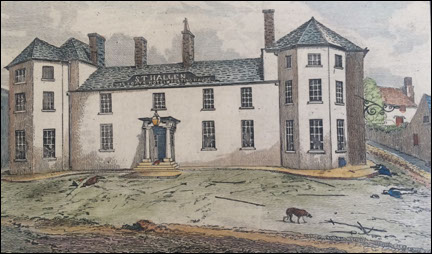
The Westgate Inn (erected 1779) in the hours following the Newport Rising of 1839
This second Westgate was constructed on the site of a fifteenth-century manor house at the bottom of Stow Hill. The earliest known resident of this ‘Westgate House’ was Sir William ap Thomas, who was lord of the manors of Sutton and Rogerstone. Many families are claimed to have been associated with the house. It is known that in 1611, Roger Kemeys sold the manor to Henry Morgan of Penllwyn, a member of a wealthy cadet branch of the Morgans, with lands in the Sirhowy valley. In the eighteenth century, a Catholic family - Jones of Llanarth Court - acquired the land. This estate leased land for the building of St. Mary’s Church and late in the nineteenth century, the Jones family adopted the name of Herbert.
By the nineteenth century, Newport was changing rapidly as industrialisation began to make its mark. Pigot’s Monmouthshire Directory (1822) shows that the Westgate Inn was now being run by Messrs. W. and S. Iggulden. They vacated the building in the 1830s and took on the management of the Carpenters Arms in High Street.
Samuel T. Hallen took possession of the Westgate Inn in May 1837, and remained its proprietor for more than 45 years. A commercial directory of 1848 describes Hallen as an ‘Innkeeper, Livery Stable Keeper, Postmaster and Patent Hearse Proprietor’
.
It was the Newport Rising of 1839 that gave the Westgate Inn the notoriety that the building still enjoys to this day. In the conflict that took place on 4th November 1839, at least twenty-two people were killed. Many more were injured, including the Mayor, Thomas Phillips, and the proprietor of the inn, Samuel Hallen. In 1840, the Newport artist, James Flewitt Mullock produced a lithograph of the attack on the Westgate, an event he had witnessed from a building opposite. Hallen’s name plate is shown above the doorway.
In the aftermath of the Rising, Hallen became embroiled in bitter recriminations. A story emerged in the national newspapers that a Chartist ‘ringleader’ named William Cardo had travelled to Newport via the Birmingham and Worcester stagecoach ‘Hero’ on Thursday 12 November, and stayed at the Westgate Inn that night. It was suggested that Cardo attempted to extract as much information as he could about the Rising from Samuel Hallen. Having ‘avowed that he was a Chartist’, he told the landlord that he need not entertain any fears, as ‘he was a lover of peace, law and order’. The Mayor had already received a letter from Francis Burgess, the Commissioner of Police in Birmingham, informing him that Cardo was on his way to Newport and Monmouth. Consequently, Cardo was detained and interrogated by the Newport magistrates.
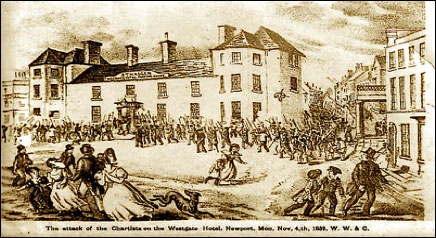
James Flewitt Mullock’s lithograph of the attack on the Westgate Inn, 1840
By the early 1880s, Samuel Hallen was living at Eveswell House in Maindee, but spent much of his time in the town tending to his businesses. On 5 July 1883, after eating lunch at the Westgate as usual, he travelled to a property in Kensington Place, Maindee to meet a potential tenant. The Western Mail reported that, while showing the Rev. T.D. Griffiths the back of the property, ‘… he was standing on the top of a flight of steps. As he stood with his face to the house he fell backwards down the steps, and was killed’. It was believed that he had broken his neck. He was 70 years of age, had been married twice and had children from both marriages. Following his death, his widow continued to occupy the Westgate Inn until Monday 31 March, 1884, when the old Westgate finally closed its doors . With the building scheduled for demolition, she moved to London and lived for another thirty-five years.

Demolition Sale
In April 1884 a four-day sale took place before the demolition commenced. The South Wales Daily News reported that many of the contents of the old building had been auctioned at a ‘sale of curiosities’ in the Westgate. The Newport Free Library Committee had decided to bid for two items relating to the Chartist Rising. This decision was not without controversy, as one committee member indignantly argued that the 20 guineas set aside for purchases should be allocated to the Pillgwenlly branch reading room. Indeed, the Newport Free Library had only found a permanent home in Dock Street itself in November 1882, and had ambitions to extend its services to other parts of the town. Having failed in its bid for a Chartist pike, the Library successfully purchased an oil painting of Lieutenant Basil Gray, who had commanded foot soldiers of the 45th Regiment inside the Westgate during the Newport Rising. This painting remained in the art collections of the Free Library and is now in storage, awaiting restoration, at Newport Museum and Art Gallery. The pike was bought by Thomas Phillips Price, the nephew of the late Sir Thomas Phillips, the mayor of Newport in 1839, for ten guineas.
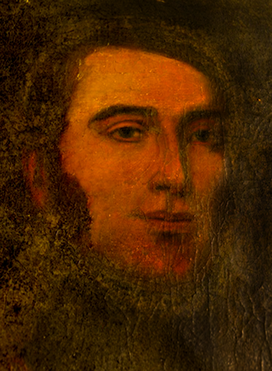
The portrait of Lt. Basil Gray, purchased by the Free Library in 1884
(Newport Museum & Art Gallery)
The third Westgate Inn
The Westgate Hotel Company had been formed at the beginning of 1884 to take over the business of the hotel and to re-build the premises. A block plan, which involved widening Stow Hill, was submitted to the council in March and was approved the following month. It was intended that the building would be ready for furnishing by December 1885, and would be run by Mr Samuel Dean of the Castle Inn, Commercial Road; the hotel was later leased to Dean for a period of twenty-one years. Dean, who witnessed all these changes, recorded that,
In excavating underneath the old (Chartist) Westgate Hotel, preparing for the foundations of the present building, the workmen came across an old spiral stairway, and at the bottom a stone porch, forming the entrance into a subterraneous passage or subway, was discovered, leading under the road (Stow Hill) in the direction of Messrs. Smith's property. The contractor being satisfied did not proceed further, and the place was filled in.
The demolition of the old building had begun on Tuesday 27 May, with the stone archway and spiral stone steps being discovered some weeks later. These steps appear to have led to a guardroom below and were photographed and inspected by a group of gentlemen, including Octavius Morgan. A relic found was a ‘mutilated silver penny’. Yet not everything was destroyed. It was decided that, in the vestibule, ‘the bullet-pierced pillars of Chartist memory will receive a place of honour, and will be a sufficient contrast to the rest of the fittings to attract attention’, and to this day, these pillars continue to hold a fascination for visitors.
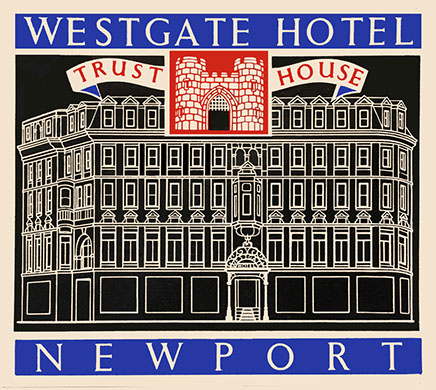
The foundation stone for the new hotel was laid Monday afternoon, the 21st July by E. J. Grice, vice-chairman of the Westgate Hotel Company. It was originally intended that this task would be performed by Crawshay Bailey, but he had unexpectedly been called away to London. At a luncheon to mark the event, the company expressed its desire to ‘put up a building that could not be equalled in South Wales’, with five shops on the ground floor, a large banqueting room, with spacious coffee, drawing and commercial rooms, and fifty-one bedrooms on the upper three floors.
This, however, was not the only prestigious building project under way in Newport in 1884. A new town hall, which was to stand proudly in the centre of Newport until 1965, was also under construction, illustrating the late-Victorian desire for larger and more elaborate buildings. On 20 May 1884, the South Wales Daily News wrote that,
The Newport of olden days is disappearing beneath the spade and shovel of the reconstructor, whilst at the same time the borders of the borough are continually extending outwards, and yet the supply especially in the Alexandra Dock district, does not keep pace with the demand. In the principal street of the borough the changes are yet more significant of the greater Newport of the future. The new Town-hall front, although somewhat cribbed, cabined, and confined, will with its clock tower, mark a new era in the architecture of the locality… the Westgate Hotel, round which lingers the odour of misguided Chartism, is being shorn of everything it contains, prior to demolition and the erection on its site of a building more in consonance with the requirements of modern, social and commercial life …
The new hotel was intended to be the most imposing building in the borough of Newport. The construction work was to be carried out by John Linton, a local builder, from designs by the architect E. A. Lansdowne. Linton won the contract with a tender of £15,200. His plans were ambitious, with the elevations facing Commercial Street and Stow Hill designed to be built in the renaissance style, incorporating large amounts of Pennant stone from Abercarn in small random rockwork; the dressed Beer stone that accentuated it was acquired from a quarry in Seaton, Devon.
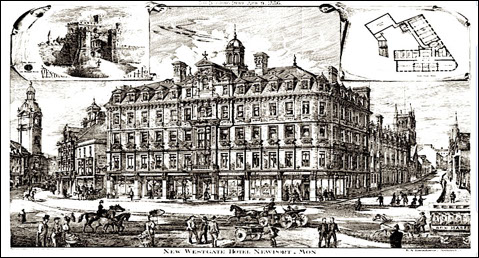
The ‘third’ Westgate when it opened in 1886
In May 1885 Dean requested that another floor be added to the new building. The attics eventually were to contain six large servants’ bedrooms. The open yard at the back of the hotel provided a large coach-house and stabling for ten horses, public toilets and urinals, with back entrances to the kitchen and the first and second floors of the hotel.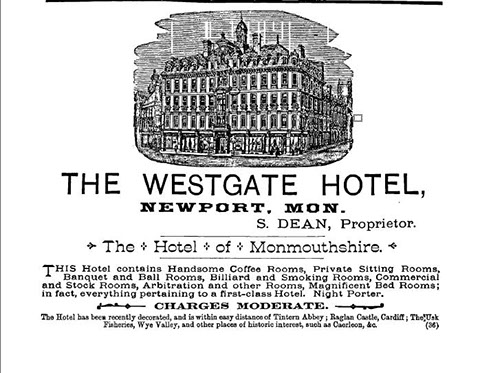 The following January, the Borough Council accepted a tender from Linton to pave the Westgate Hotel. The new hotel, with Sam Dean as proprietor, opened on 6 May 1886 with an Inaugural Banquet for 150 local notables. Speeches were made by the Mayor, Mr E. J. Grice, and by several gentlemen, members of the Westgate Hotel Company.
The following January, the Borough Council accepted a tender from Linton to pave the Westgate Hotel. The new hotel, with Sam Dean as proprietor, opened on 6 May 1886 with an Inaugural Banquet for 150 local notables. Speeches were made by the Mayor, Mr E. J. Grice, and by several gentlemen, members of the Westgate Hotel Company.
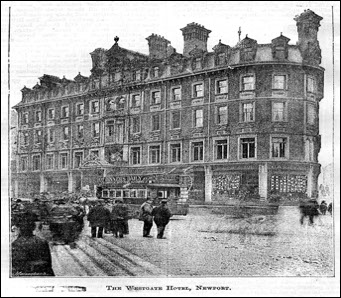
The Westgate Inn in 1892
The Westgate Hotel Company ran the business until the early 1920s, when it was sold to Trust House Forte in 1923. In 1981, it was acquired by Stock Services before being sold on, four years later.
The portico and its pillars
The original portico, seen in the Mullock lithograph, was eventually pulled down on Wednesday 17 September 1884. For many years, it has been famously claimed that the holes in the pillars of the old hotel, preserved inside the entrance, were made by bullets or musket balls during the Newport Rising.
Sceptics have suggested that the holes were, in reality, drilled into the pillars to make fixings for doors, gates or railings. This, very definitely, flies in the face of the newspaper reportage during the rebuilding of the mid 1880s.
The Monmouthshire Merlin reported that, ‘… in the pillar that suffered the most on the occasion of the Chartist riots the workmen came across several roughly-made bullets, one with a nail driven through the centre of it’. The newspaper added that, ‘… the bullets have doubtless lain where they were found ever since the memorable attack on the hotel 45 years ago’.
Three days later the Western Mail confirmed that, in one of the pillars, three bullets were found.
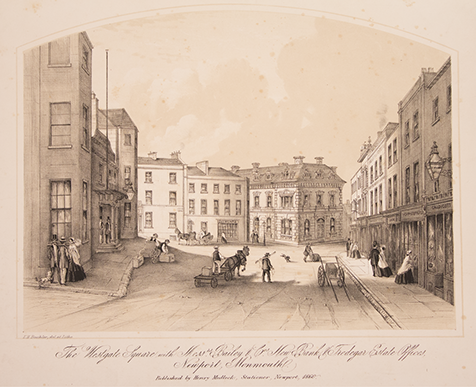
1860 print showing the bullet holes
W.N.Johns was writing The Chartist Riots at Newport: November 1839 whilst the work was being undertaken. Although published 1889, the fiftieth anniversary of what were then called the ‘Chartist Riots’, he had in fact issued a limited and very rare edition of this volume three years earlier in 1886, the year that the new Westgate Hotel opened. Johns commented that,
On the removal, on September 17th, 1884, of the wood pillars which supported the porch front of the Old Westgate, there were found four roughly-made bullets or slugs, which had evidently lain in the interior of the pillars since the day of the attack on the building – forty-five years before.
The historical evidence suggests that the bullet holes are real and that Johns accurately described what had taken place. Both he, and the newspaper accounts from the 1880s, would seem to be correct.
A close inspection of the hollow timber pillars is sufficient to dismiss the ‘gate theory’. The holes are irregular, and not what would be expected for hanging railings. The pillars were originally located outside the entrance door and it seems the pillars may have been rotated when re-erected inside the new building. This means that the pillars were in the direct line of fire of both soldiers and Chartists. Nevertheless, to arrive at any forensic conclusion on this point, a professional endoscopic investigation is required, in which a miniscule camera will be placed through the holes, checking for any markings on the inside of the pillars.
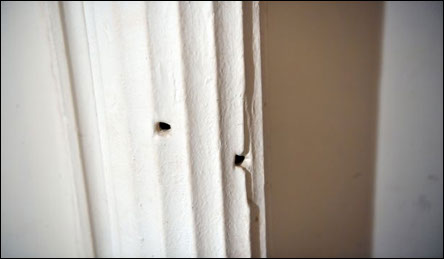
The holes found in the pillars as they look today
Photo: R. Stroud (2019)
Other images of the Westgate Hotel
John Wright Painting of the Westgate
Just before Wildings Department Store closed down the owners donated a painting by John Wright of the 1839 Westgate Rising. The painting now in Newport Museum and Art Gallery, is based on the Mullock image above.
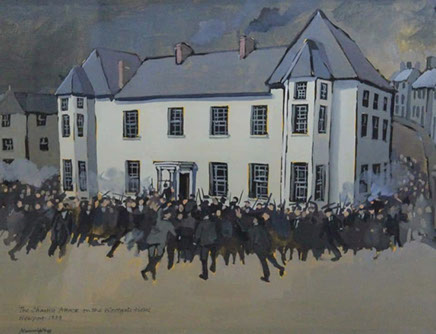
John Wright (1931-2013) was Principal of Newport Art College before his retirement in 1986.
Pennywise print
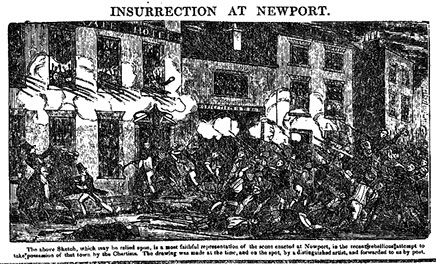
This contemporary print from the Pennywise magazine purports to be an accurate description of the attack on the Westgate drawn by an observer of the scene but bears little resemblance to the architecture of the building.
Scenes from the 175th Anniversary
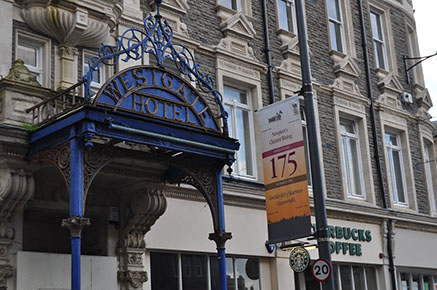
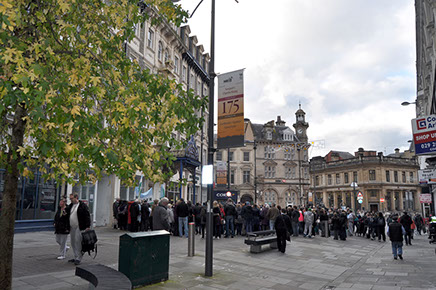
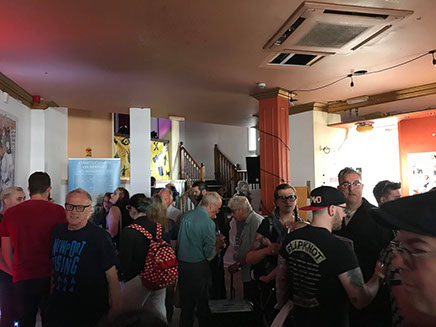
In 2019 Our Chartist Heritage and Newport Rising reclaimed the hotel temporarily to celebrate the launch of the post Holocaust edition of the graphic Novel "Newport Rising" by Rhys D.W. and Josh Cranton.
The Rising team were allowed by the owners of the hotel to renovate parts of the building in preparation for the "Rising" weekend in November 2019 that included a range of Chartist events. The highlight was the Torchlight march from Belle Vue park to the Westgate that ended in a long night of celebration with music, voice and Chartist ale inside the hotel. (below)
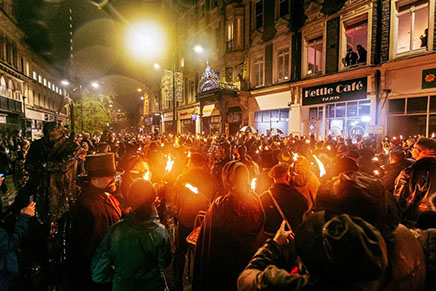
For more information visit the Newport Rising facebook page
Advert from Kelly's Directory 1848
2019 launch of the
Rhys DW/Cranton
Graphic Novel









